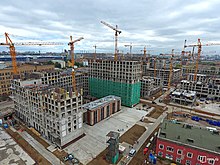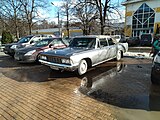ZiL
Automotive Defence | |
| Founded | 1916 |
|---|---|
| Fate | Production ended in 2012 |
| Headquarters | , Russia |
Key people |
|
| Products |
|
| Revenue | $12.1 million[1] (2016) |
| -$19 million[1] (2016) | |
| -$21.5 million[1] (2016) | |
| Owner | City of Moscow Property Department[2] |
| Website | www |
OJSC AMO ZiL, known fully as the Public Joint-Stock Company – Likhachov Plant (Russian: Публичное акционерное общество – Завод имени Лихачёва, romanized: Publichnoye aktsionernoye obshchestvo – Zavod imeni Likhachyova) and more commonly called ZiL (Russian: ЗиЛ), was a major Russian automobile, truck, military vehicle, and heavy equipment manufacturer that was based in Moscow.
The last ZiL vehicle was assembled in 2012. The company continues to exist only as real-estate development site, on which a new urban district will be built by the LSR Group construction company.[3]


History

The factory was founded on 2 August 1916 as the Moscow Automotive Society or AMO (
In 1929—1931, the factory was re-equipped and expanded with the help of the American A.J. Brandt Co.,[8][9] and changed its name to Automotive Factory No. 2 Zavod Imeni Stalina (ZIS or ZiS). After Nikita Khrushchev denounced the cult of personality of Joseph Stalin in 1956, the name was changed again to Zavod imeni Likhachyova, after its former director Ivan Likhachev.[10]
- ZiS luxury vehicles
-
ZIS-101 (1936)
-
ZIS-102 (1937)
-
ZIS-101A Sport (1939)
-
ZIS-110 (1945)
-
ZIS-110B (1949)
ZiL lanes, road lanes dedicated to vehicles carrying top Soviet officials, were named after the car. The ZiL limousines were the official car that carried the Soviet heads of state, and many Soviet Union allied leaders, to summits or in parades. The limousines were flown to international summits as, for example, in 1987 and 1990 to Washington, D.C. in the US for Mikhail Gorbachev's official state visits.[11][12]
ZiL had a history of exporting trucks to Cuba, trade resumed in the early 21st century.[13]
The ZiL factory is portrayed in a number of English language documentaries. The 2001 documentary by Daniel Leconte, Lenin if you knew (renamed USSR Memories), follows the fate of a family associated with the factory as well as the factory itself in the 1990s.[14] The factory is also a feature of the 2014 documentary, The Last Limousine.[15]
- ZiL luxury vehicles
-
ZIL-111G (1962)
-
ZIL-114 (1967)
-
ZIL-117 convertible (1971)
-
ZIL-4104 convertible (1981)
-
ZIL-41047 (1985)
After the final ZiL limousine was built in 2012, the Moscow factory administration stopped truck production and the company was declared bankrupt in 2013. ZiL still exists as a legal entity, but produces no vehicles. In 2014 it was announced that the factory site will be turned into a residential development.[16] Most factory buildings were dismantled in 2015.[17]
The factory's equipment and other automotive assets were auctioned off to a new company, "MSTs6 AMO ZIL". It employs 47 staff, mostly former ZiL workers.[18] The company took part in the Moscow International Automobile Salon 2016.[19]
After the building of "MSTs6 AMO ZIL" was demolished in 2020, it was believed that the company ceased to exist. However, it was reported in 2021 that MSTs6 continued to operate. Its staff and equipment were moved to the Moscow Oblast.[20]
Awards
- In June 1942 the VMS was awarded the first Order of Lenin for the excellent organization of the production of ammunition and weapons.
- In October 1944 the plant was awarded the Order of Red Banner of Labour.
- In 1971 the plant was awarded the Order of Lenin for the third successful implementation of the Eighth Five-Year Plan.
- In 1975 the plant was awarded the Order of the October Revolution for the successful completion of works on creation of capacities up to 200 thousand cars per year issuance.
See also
- List of ZiL vehicles
- Soviet Artillery Factory No. 92— also named Zavod imeni Stalina (ZiS).
- GM "old-look" transit bus: Soviet versions — ZiS-154 and ZiS-155 models.
References
- ^ a b c "Бухгалтерский баланс на 31 декабря 2016 г." (PDF).
- ^ "Список аффилированных лиц". e-disclosure.ru. Archived from the original on 26 August 2017. Retrieved 26 August 2017.
- ^ "99 Years of ZiL: From Car Plant To Potential New Heart of Moscow?". Moscow Times. Archived from the original on 6 April 2017. Retrieved 5 April 2017.
- ^ Sutton, Antony C. (1968). Western technology and Soviet economic development, 1917 to 1930. Hoover Institution on War, Revolution and Peace. pp. 244–249. Archived from the original on 28 November 2016. Retrieved 22 December 2017.
- ^ "AMO-ZIL website, history 1916-1923" (in Russian). Archived from the original on 5 October 2018.
- ^ "AMO-ZIL website, history 1924-1931" (in Russian). Archived from the original on 5 October 2018.
- ISBN 978-5-2760-2388-5. Archived(PDF) from the original on 5 October 2018. Retrieved 10 October 2018.
- ^ Sutton 1973, p. 122.
- ^ "Как в 1929−1931 годах модернизировали ЗИЛ" (in Russian). Mos.ru. 1 October 2020. Retrieved 23 February 2022.
- ^ Straus 1998, p. 33.
- ^ Michael Dobbs (22 November 1990). "Crises now follow Gorbachev abroad". The Washington Post. Retrieved 23 February 2022.
- ^ Saundra Saperstein Torry, John Mintz (5 December 1987). "Gorbachev is city's most shielded visitor". The Washington Post. Retrieved 23 February 2022.
- ^ "ZIL resume exports to Cuba". Archived from the original on 3 September 2016. Retrieved 7 September 2016.
- ^ Leconte, Daniel (2001). "USSR Memories - Daily life of a Russian family in the Soviet Union". Youtube. wocomoDOCS. Retrieved 20 June 2023.
- ^ "'The Last Limousine' ('Posledniy limusin'): Vladivostok Review". The Hollywood Reporter. Archived from the original on 21 April 2017. Retrieved 9 June 2017.
- ^ Нехлебова, Наталия (31 October 2016). "ЗИЛ после жизни". Журнал "Огонёк". p. 10. Archived from the original on 5 May 2017. Retrieved 9 June 2017.
- ^ Sorokina, Anna (8 August 2017). "How a Soviet auto giant became a ghost factory". Russia Beyond The Headlines. Archived from the original on 30 January 2018. Retrieved 22 August 2017.
- ^ Завод индивидуальных лимузинов. Русский Автомобиль (in Russian). Archived from the original on 8 June 2017. Retrieved 9 June 2017.
- ^ Стенд ЗИЛ на Московском автосалоне (in Russian). Livecars.ru. 27 August 2016. Archived from the original on 3 July 2017. Retrieved 9 June 2017.
- ^ Давид Акопян (14 December 2021). "Здесь был ЗИЛ. Репортаж о легендарном заводе, которого не стало" (in Russian). RBC Autonews. Retrieved 23 February 2022.
Literature
- Straus, Kenneth M. (1998). Factory and Community in Stalin's Russia: The Making of an Industrial Working Class. University of Pittsburgh Press. p. i. ISBN 978-082298584-6.
- Sutton, Antony C. (1973). National Suicide: Military Aid to the Soviet Union. New Rochelle, N.Y.: Arlington House. ISBN 978-087000207-6.
External links
- (in Russian)—Official MSTS6 ZIL website
- (in Russian)—Official ZiL website
- From Soviet Russia With Love - article about presidential limousines made by the company










